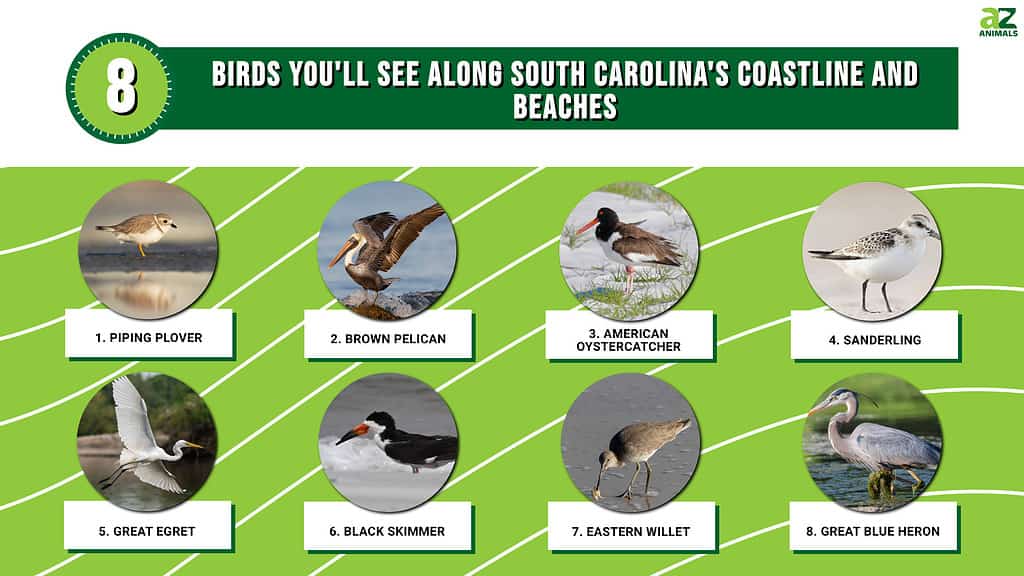
South Carolina’s sun-dappled shores and pristine beaches aren’t just a paradise for beachgoers. They’re also a haven for an array of birds! The state’s coastal landscapes serve as permanent homes and migratory stopovers for countless avian species. This offers bird watchers and nature lovers a unique spectacle of feathered diversity. In this article, we will explore and get to know the birds that call South Carolina’s coastline and beaches home.
1. Piping Plover (Charadrius melodus)

At only 7 inches tall, the piping plover is a tiny bird that feeds on invertebrates.
©Bouke Atema/Shutterstock.com
The piping plover is a compact bird, standing at approximately 7 inches in height and weighing roughly 2 ounces. It has a sandy-colored back and a white underbody, providing camouflage in beach environments. It possesses a black stripe between the eyes and around the neck, notably more visible in the breeding season. The piping plover’s short and thick bill aids in foraging, while its orange legs differentiate it from similar species.
The piping plover consumes a range of beach-dwelling invertebrates, such as marine worms, beetles, crustaceans, and other small creatures. They display a unique “run-stop-peck” feeding pattern, where they dash across the beach, stop to scrutinize the sand, and then peck at possible prey. Their preferred habitats are sandy or gravel beaches and alkali flats with lower vegetation, areas that offer both food and nesting sites. Their nests are shallow indentations in the sand, frequently encircled with pebbles or shell debris.
Piping plovers are timid and are susceptible to disruptions. Habitat loss has contributed to their status as a threatened species in several regions.
2. Brown Pelican (Pelecanus occidentalis)
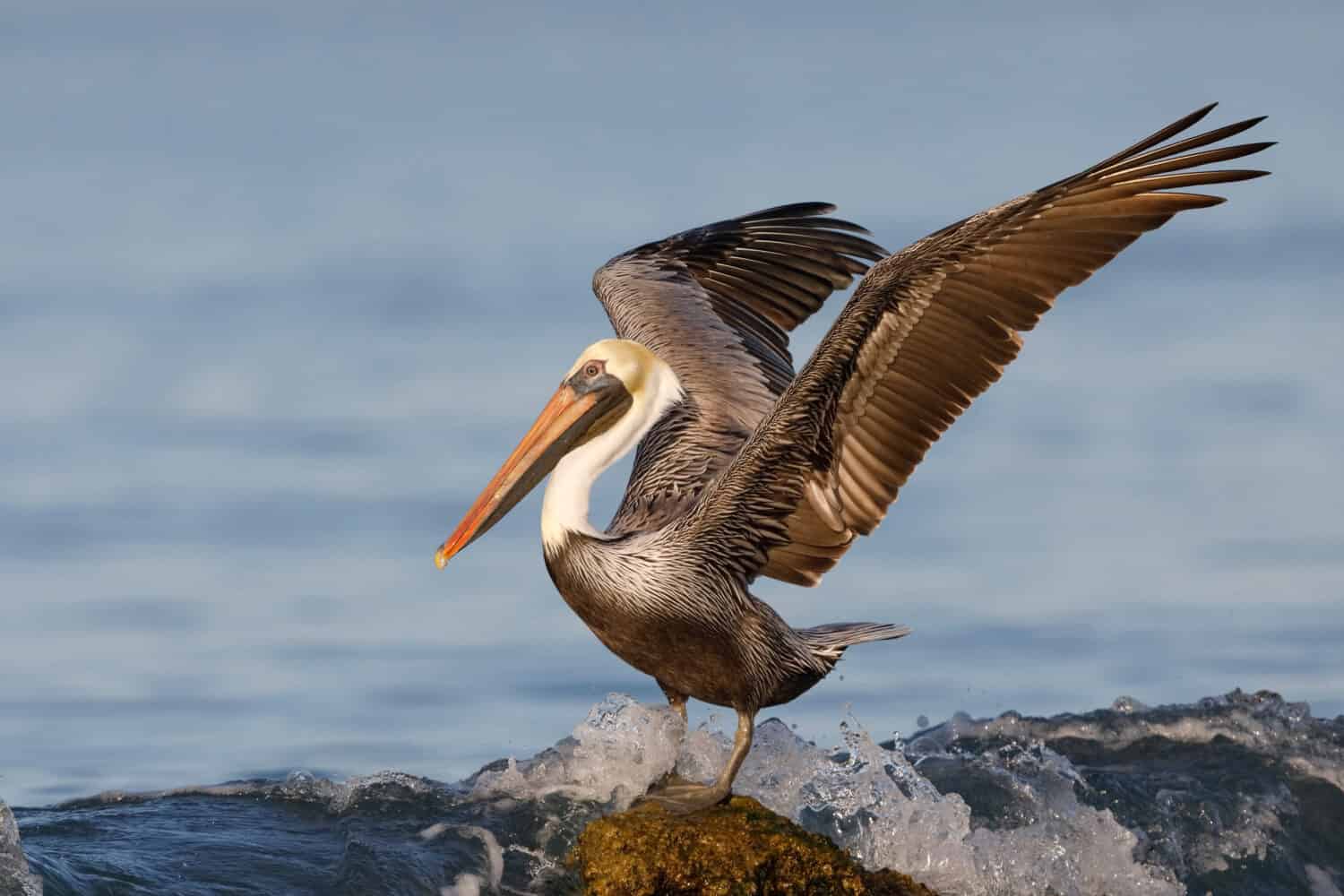
Although incredibly large, the brown pelican is graceful in flight.
©Brian Lasenby/Shutterstock.com
The brown pelican is a familiar bird seen along South Carolina’s coast and beaches. It possesses a sizeable body, a wingspan of 6 feet, and a lengthy bill with a large throat pouch. The mature brown pelican’s plumage is typically grayish-brown in color. It has a white head adorned with a light yellow crown and a dark brown neck that turns a rich dark reddish-brown during the breeding season.
Brown pelicans primarily consume fish, demonstrating dramatic dives from heights up to 60 feet to catch their prey before trapping fish in their bill pouch. They then drain the water from their pouch and tilt their head backward to swallow the fish.
Brown pelicans live in warm coastal waters, estuaries, and lagoons and often congregate to roost and feed. They also nest in colonies on predator-free islands, usually laying 2-3 eggs on the ground or in trees or shrubs.
Despite their large size and seemingly clumsy demeanor on land, brown pelicans exhibit graceful flight. They are commonly seen in a V formation or gliding close to the ocean’s surface. Their noteworthy flight skills and group behaviors contribute to the captivating character of the coastal areas they inhabit.
3. American Oystercatcher (Haematopus palliatus)
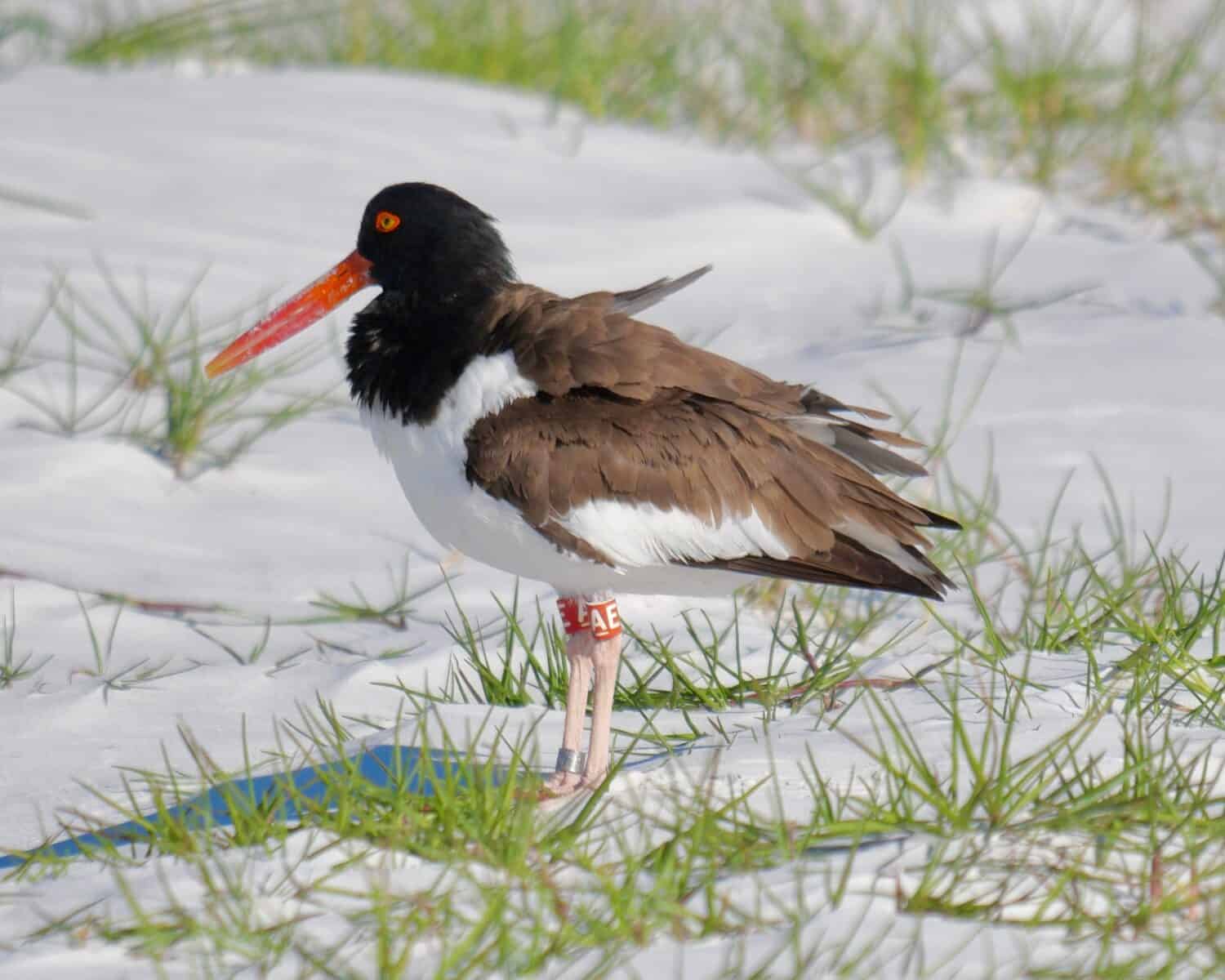
As its name suggests, the American oystercatcher loves to eat oysters and other shellfish.
©Archaeopteryx Tours/Shutterstock.com
The American oystercatcher is a striking, large shorebird, often recognized by its distinctive appearance. The bird has a primarily black body and head, contrasted with a white belly and a vibrant, long, orange-red bill specifically adapted to pry open shellfish. Its eyes feature a yellow iris surrounded by an orange orbital ring, enhancing its striking looks. Furthermore, its stout legs, colored a dull pink, enable it to navigate the rocky intertidal zones that are its preferred habitats.
As its name suggests, the American oystercatcher’s diet primarily comprises shellfish, including oysters, clams, and mussels. The bird uses its uniquely shaped bill to open shells by stabbing into the shell to cut the muscles and then eating the mollusk or hammering it open. These birds are usually found along the coastline on beaches, rocky shores, and mudflats, where their food sources are plentiful.
The American oystercatcher is a vocal bird, often seen and heard in pairs or small groups. Its behavior includes a characteristic flying pattern with solid and steady wing beats. This bird is known to nest on the ground, where it can lay up to 4 speckled eggs. Despite the challenges posed by habitat loss and human disturbance, this species has been gradually expanding its range northward along the Atlantic coast over the past few decades.
4. Sanderling (Calidris alba)

Interestingly, the sanderling does not have a hind toe.
©Bouke Atema/Shutterstock.com
The sanderling is a small, energetic bird often observed scampering on sandy beaches in South Carolina. Its summer plumage features a rusty-red upper body, while in winter, it transforms into a nearly uniform light grey and white coloration that helps it blend into the sandy beaches it frequents. Sanderlings have short, straight, black bills and relatively long, black legs. The most distinctive feature of these birds is the absence of a hind toe.
When it comes to a sanderling’s diet, sanderlings are insectivorous and also consume small crustaceans. To feed, they chase receding waves on the beach to forage for small invertebrates left in the wet sand, then swiftly retreat from the incoming waves — a charming spectacle often likened to a merry dance.
The preferred habitats of the sanderling are sandy beaches and mudflats, and they are most commonly seen in large flocks. When it comes to breeding, sanderlings nest in the high Arctic tundra, migrating impressive distances to winter on shores virtually worldwide.
5. Great Egret (Ardea alba)
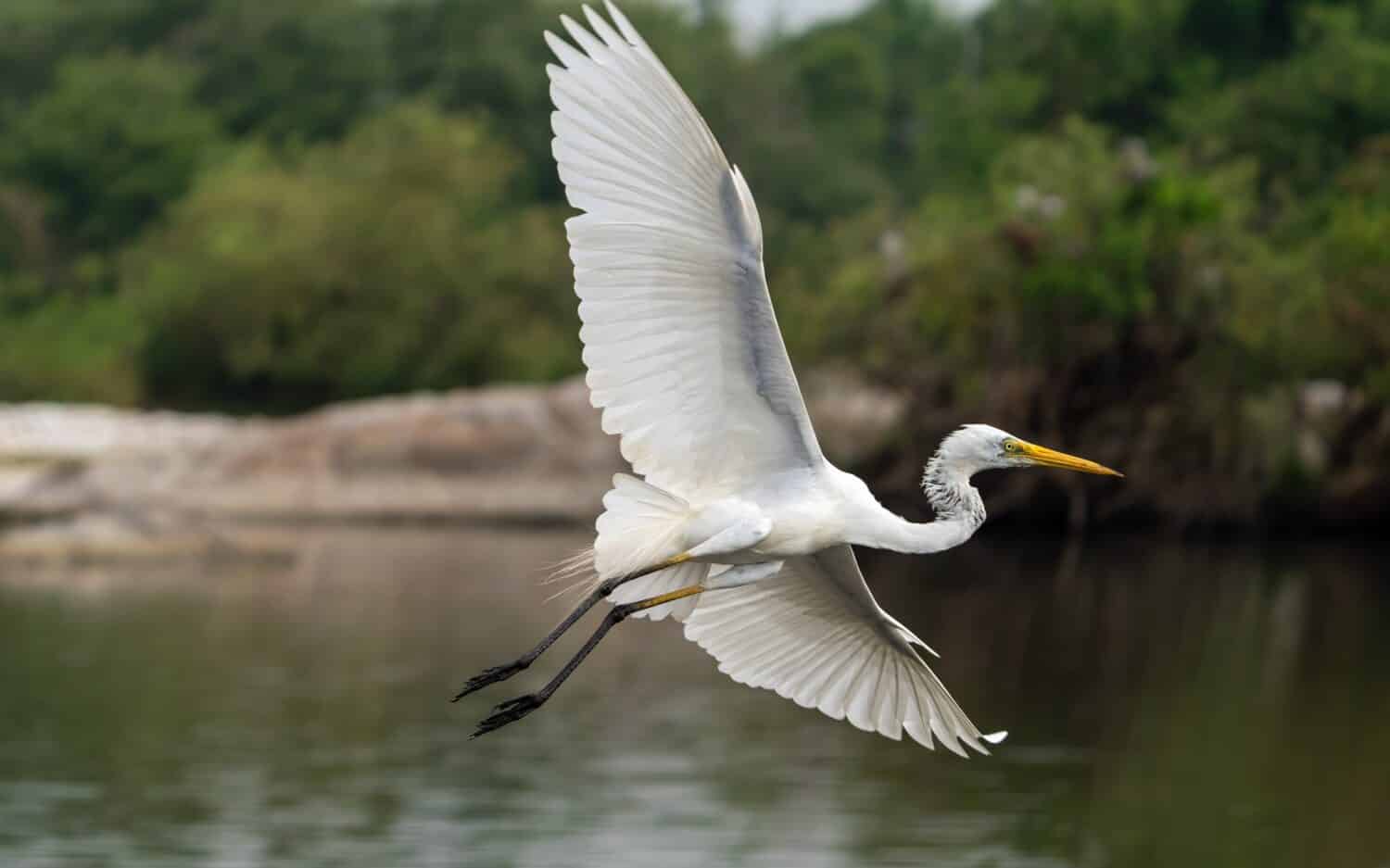
The beautiful plumes of the great egret were once highly sought after for hats.
©Banu R/Shutterstock.com
The great egret, sometimes known as the common egret, is a remarkable sight in wetland habitats. Standing up to 3 feet tall, with a wingspan that can reach 5.6 feet, it’s one of the more prominent members of the heron family. The bird is slender with an entirely white body, long black legs, and a sharp yellow bill. During the breeding season, the great egret showcases beautiful, long, ornamental plumes on its back that were once sought after for the hat trade.
Feeding primarily on fish, the great egret has an interesting and patient hunting strategy. It quietly stalks its prey in shallow water, often standing motionless for some time and striking quickly when a fish comes within range. It’s not uncommon, however, for these birds to also eat amphibians, small mammals, birds, and invertebrates when the opportunity arises.
The great egret is a common resident in marshes, ponds, and along shores of both saltwater and freshwater habitats. This bird is also found in fields and wet grasslands.
Great egrets are solitary nesters or breed in colonies, often with other wading birds. Their nests are platforms of sticks built high in trees near or over water.
6. Black Skimmer (Rynchops niger)
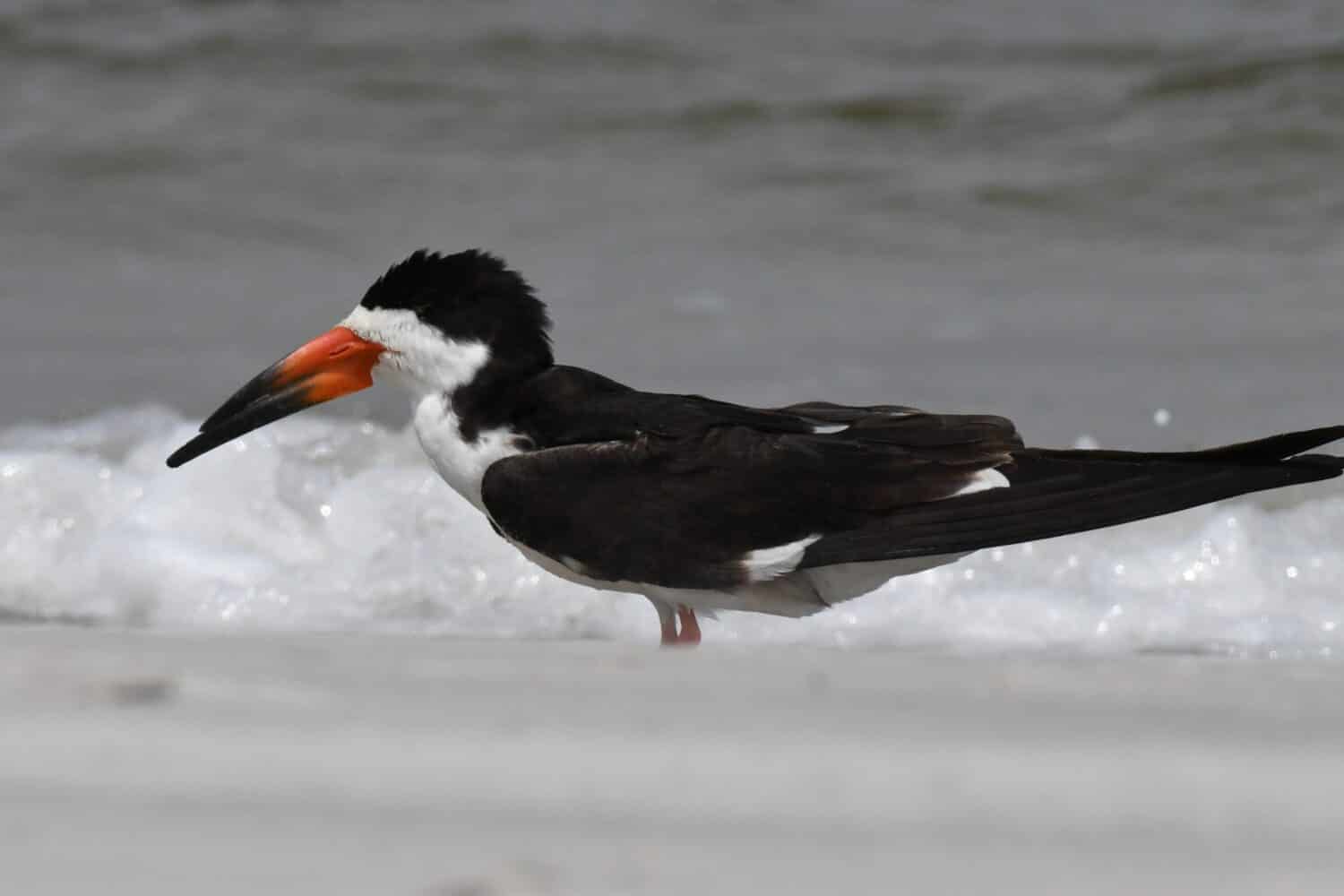
A coastal bird with a very noticeable bill, the black skimmer stands out against the sand.
©Gilbert S. Grant/Shutterstock.com
The black skimmer is another striking, coastal bird known for its outstanding bill and feeding style. It sports a black back and cap, contrasting sharply with its white underparts. However, the black skimmer’s most noticeable feature is undoubtedly its bill – large and knife-like, with the lower mandible noticeably more extended than the upper. The black skimmer has a graceful silhouette during flight with long, pointed wings and short legs.
Black skimmers have a fascinating foraging behavior from which they derive their name. They skim the water’s surface in flight with their longer lower mandible, snapping their bill shut when they catch a fish. As such, their diet is primarily made up of small fish and crustaceans.
These birds prefer sandy or gravelly bars and beaches, salt marsh islands, and dredge spoil islands for their habitat.
During the breeding season, black skimmers are highly social, nesting in colonies often mixed with other species like terns. Their nests are superficial scrapes in the sand, frequently located in areas with sparse or no vegetation. While they’re active throughout the day, black skimmers are particularly notable for their crepuscular and nocturnal habits – a rarity among seabirds – making them a unique spectacle along the coastal shores.
7. Eastern Willet (Tringa semipalmata)
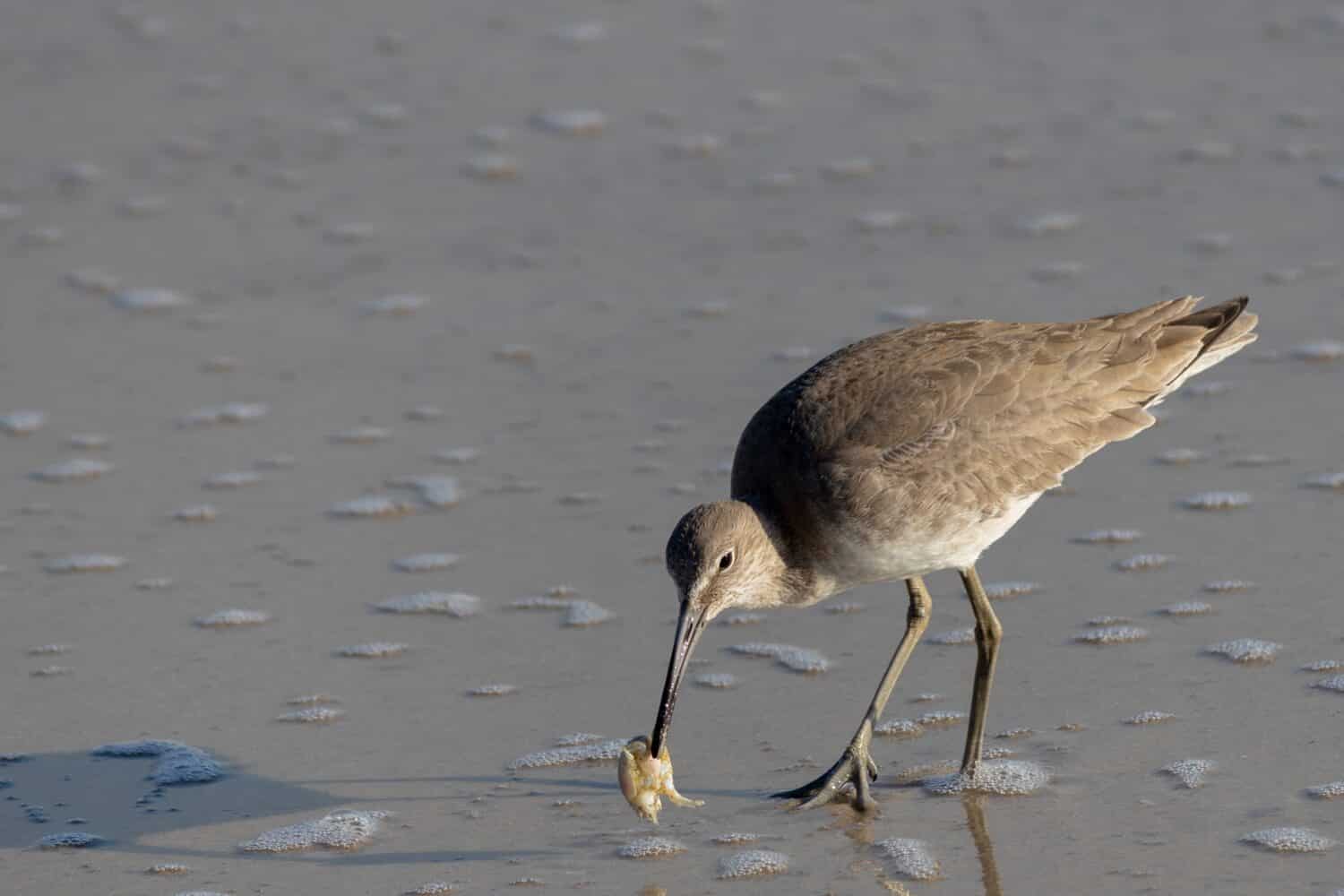
During the breeding season, the eastern willet displays aggressive behavior.
©Leodidthis/Shutterstock.com
The eastern willet, a subspecies of the willet, is a large and robust bird known for its piercing calls. It has a hefty body; tall stature; and a long, straight bill. In flight, it displays a bold black-and-white pattern. During the breeding season, the eastern willet’s plumage turns a warm brown, beautifully speckled with dark markings, while in winter, it adopts a more subdued gray coloration.
The diet of the eastern willet is diverse, feeding on insects, crustaceans, marine worms, and small fish that it catches from the water’s surface or probes in the mud to find.
The bird is known for its aggressive behavior, particularly during the breeding season, when it displays a spirited defense of its nesting territory, often engaging in aerial chases or loud, striking calls.
The eastern willet prefers various habitats, from beaches, mudflats, and salt marshes to freshwater wetlands. Its nests are usually simple depressions in the ground, lined with grass and leaves.
Among the most vocal of shorebirds, the call of the willet is an iconic sound of salt marshes and seaside beaches – a loud ringing that echoes across its habitats. With its distinctive characteristics and bold personality, the eastern willet adds a unique charm to the avian spectacle along the South Carolina coasts.
8. Great Blue Heron (Ardea herodias)
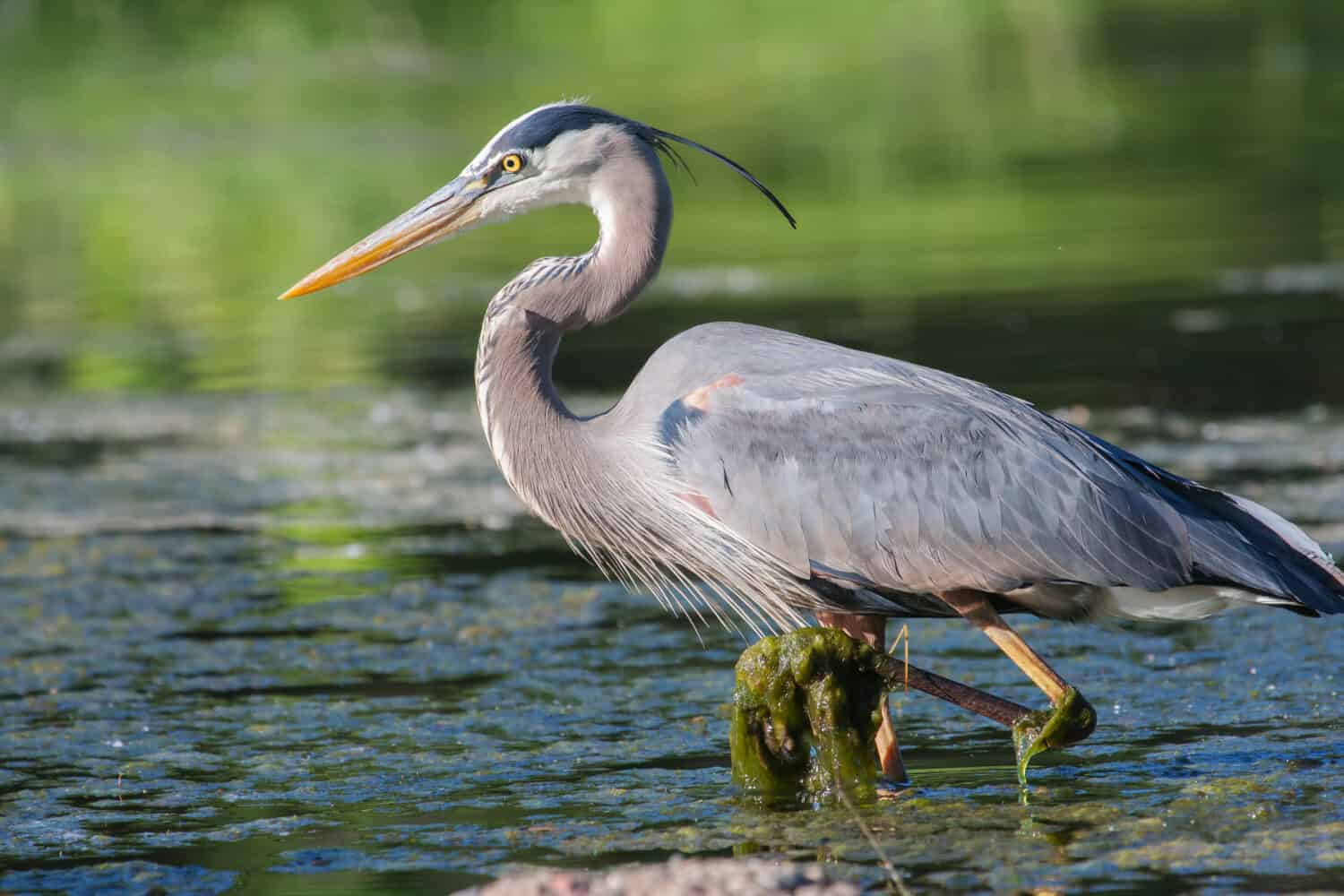
With a wingspan of 6 feet, the great blue heron is a solitary bird that nests alone.
©Joseph Scott Photography/Shutterstock.com
The great blue heron is the largest heron in North America, standing tall at around 4 feet with a wingspan of up to an incredible 6 feet. This bird’s large, slender frame is cloaked in blue-gray plumage, accentuated by a broad black stripe over its eye that extends into a plume of feathers. A white crown and throat add contrast, while long, reddish-brown thighs and a yellow, dagger-like bill complete its striking profile. In flight, the great blue heron tucks its neck into an “S” shape and trails its long, powerful legs behind, creating an imposing spectacle.
Primarily piscivorous, the great blue heron is a patient predator that feeds mainly on fish, stalking its prey in shallow waters before striking with precision. Its diverse diet includes amphibians, reptiles, small mammals, insects, and even other smaller birds in some cases.
Habitats for the great blue heron range from freshwater and saltwater marshes, mangroves, flooded meadows, lake edges, and shorelines to riverbanks and the advantages of fish hatcheries.
This bird is typically solitary in most seasons and often nests alone, although it can also be found in loose colonies. It nests in trees or shrubs near bodies of water, building a bulky stick nest.
Summary of Birds You’ll See Along South Carolina’s Coastline and Beaches
| Common Name | Scientific Name | |
|---|---|---|
| 1 | Piping Plover | Charadrius melodus |
| 2 | Brown Pelican | Pelecanus occidentalis |
| 3 | American Oystercatcher | Haematopus palliatus |
| 4 | Sanderling | Calidris alba |
| 5 | Great Egret | Ardea alba |
| 6 | Black Skimmer | Rynchops niger |
| 7 | Eastern Willet | Tringa semipalmata |
| 8 | Great Blue Heron | Ardea herodias |
The photo featured at the top of this post is © Joseph Scott Photography/Shutterstock.com
Thank you for reading! Have some feedback for us? Contact the AZ Animals editorial team.






